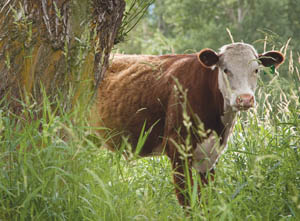
The Carman family ranch is the same type of midsized farm that the USDA recently called “the disappearing middle.” The high transaction costs of selling directly to consumers make it difficult for producers like us to sell everything we produce to niche markets. At the same time, we can’t begin to compete with the efficiencies enjoyed by large corporate farms. Add to the mix a dependence on an increasingly volatile commodity market, and it’s no surprise that 150,000 midsized farmers have recently hung up their hats.
Despite these odds, my husband and I are beating the statistics. For nearly 10 years, we’ve been selling high-quality, grass-fed beef (free of hormones and antibiotics) to a growing number of Oregon families, restaurants, and businesses. In the process, we’ve found a way to combine profitability with sustainability. The key to our recent success has come from looking beyond the typical business plan of a small-scale farmer.
For several years, the Carman Ranch divided its sales channels between conventional commodity sales and direct marketing of grass-fed beef to individual consumers. Following the lead of small farmers, we made personal connections with our customers. Their support allowed us to develop production practices that not only made a positive impact on the landscape but also yielded exceptional beef. But in order to continue these practices, we needed a premium price for our product. We couldn’t accomplish this by selling a few steaks at a time, so we looked beyond home kitchens and found customers who cooked in much larger venues.
By the time we began approaching businesses, we had the knowledge, credentials, and capacity to work with them. Customers initially came slowly, but as we further established our brand and built our reputation, interest in our product grew. Still, we were hampered by the high price of our beef. Our primary buyers, hospitals and universities, simply couldn’t afford our meat. The problem was clear: Working with a small processing plant, nearly 40 percent of our costs were incurred after the cattle left the ranch.
We knew that our ability to grow depended on finding new partners to process, transport, and distribute our beef. After many rejections, we connected with a meat distribution company that agreed to add our brand to their line of products. An unlikely partner, owned by one of the largest distributors in the country, this company took important steps to support the Carman Ranch by buying whole animal quantities and distributing a seasonal product—quite important with respect to grass-fed beef, but unheard of in conventional meat purchasing. The company also opened the door to a larger-scale and cheaper processing plant. The combination immediately lowered the price of our beef by 15 percent. Our sales took off, and in the first year, we could barely meet the new demand.
We made our exit from the commodity market by combining the relationship-based marketing that allows small farmers to prosper with the efficient distribution and processing that gives large producers a pricing advantage.
Although our buyers serve thousands of meals each day, they still find time to come out to the ranch to see the careful management practices their purchasing supports. And even though we are their smallest product line, our distributor continues to alter its systems to support our growth. Our experience demonstrates how the efficiencies of the large-scale food system, which once threatened to put many traditional family farms out of business, might turn out to be a midsized farmer’s best hope.


